Resource Saving
- Home > Sustainability > Environment >
The Shin-Etsu Group recognizes that the efficient use of limited resources and a circular economy* are key issues that companies should address. By making effective use of resources, we aim not only to contribute to the global environment, but also to increase our competitiveness and ensure sustainable development.
In terms of resource circulation, the Group collaborates with customers and related industry groups, using cutting-edge technologies to recover used products, extract resources, and reuse them in the Group’s products. Through these initiatives, it is possible to reduce the waste output of our customers and the Group itself. We are also contributing to environmental conservation by reusing resources.
In addition, we are promoting waste reduction initiatives at each location with a target of zero waste emissions (landfill waste of 1% or less of the final amount of all waste generated) at our consolidated companies in Japan.
*Circular economy
Economic activities to recycle and circulate existing resources, such as converting waste after use into resources for another business
Initiatives for Resource Circulation
Recycling of Waste Materials (rare earth magnets)
The Group manufactures rare earth magnets with our integrated production process using separation and refinement techniques to extract rare earth magnets from rare earth raw materials.
Since 2007, the Group has been recycling the magnet powder generated by our manufacturing processes for rare earth magnets as one of our measures for the stable procurement of raw materials. Furthermore, since March 2013, we have also been developing techniques to recycle the rare earth magnets used in recovered power-saving air conditioners and hybrid cars in order to reuse resources.
These initiatives have made it possible to reduce the environmental impact that comes along with resource development and to safely and securely protect the valuable resource of rare earth. The Group’s rare earth magnets create significant economic and social value as recycled products and also contribute significantly to energy conservation.

Rare Earth Magnet Resource Recycling Process
Magnet recycling project with Toyota Motor Corporation
The magnets used in hybrid vehicle motors contain the rare earths neodymium and dysprosium. We are collaborating with Toyota Motor Corporation to recycle the extracted neodymium and dysprosium into new magnets.

Source: “Vehicle Recycling” Toyota Motor Corporation
Recycling of Used Products (PVC)
Initiatives to recycle products containing PVC are making progress. There are various methods for recycling PVC, the most common of which is material recycling.
Material recycling uses used PVC products as raw materials to create new PVC products. PVC pipes, flooring materials, and other PVC products are not greatly influenced by foreign substance contamination, so various kinds of recycling are conducted for those products. In particular, 60% of used PVC pipes and joints are recycled for reuse in new PVC pipes and joints, and 70% of agricultural film is recycled for use in flooring material.

Examples of Recycling PVC Products
Related Information
Shintech obtains +Vantage Vinyl® Silver certification
+Vantage Vinyl® is a voluntary effort by the U.S. vinyl industry to contribute to sustainable growth. It seeks to mobilize the efforts of companies across the U.S. vinyl industry value chain to drive continuous improvement across all three sectors of sustainability—environmental, social and economic performance. Silver certification is awarded to companies that have demonstrated greater than 80% conformance to all applicable guiding principles and have implemented at least one advanced practice. The organization’s recycling grant program, called VIABILITY, which is supported by Shintech and other vinyl industry companies, has awarded more than $1.6 million in grants to promote post-consumer PVC recycling. Through these efforts, the vinyl industry is working to expand the recycling and re-use of PVC.
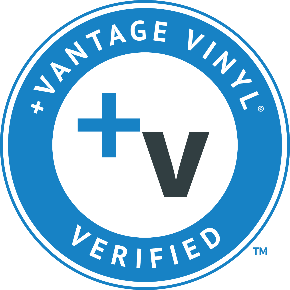
+Vantage Vinyl® Silver certification
Related Information
Recycling the Use of Product Shipping Cartons
Shin-Etsu Chemical has started recycling product shipping cartons for heat-dissipating silicone grease.
Heat-dissipating silicone grease must be transported while frozen to stabilize its product quality. Therefore, we used dry ice to cool products in disposable boxes in transit in the past. As a result of extensive research conducted collaboratively with customers, the company has successfully developed the new packaging that can be recycled multiple times while maintaining optimal temperatures. In addition, this new packaging eliminates the need for dry ice. Such customer engagement also contributes to the reduction of CO2 emissions in the supply chain.
Waste Reduction Initiatives
As part of our efforts to conserve resources, the Shin-Etsu Group is promoting waste reduction initiatives at each location with a target of zero waste emissions (landfill waste of 1% or less of the final amount of all waste generated) at our consolidated companies in Japan.
Shin-Etsu Chemical’s Naoetsu Plant is promoting waste reduction through the recycling of waste and reducing the weight of the waste generated in its manufacturing processes as outlined below.
Recycling of Waste Materials
The Naoetsu Plant promotes activities to reduce waste materials generated in manufacturing and processing. For example, we take the paper materials that would otherwise be discarded in the manufacturing process, and we effectively utilize them by making recycled paper. We are also proactively considering ways to recycle the solvents from chemical reaction processes or create formulations that allow them to be reused.

Reducing the Weight of Waste for Disposal
The plant’s wastewater treatment facilities separate and dehydrate the inorganic solids contained in the wastewater to make a solid sludge. This sludge is treated as industrial waste by an external contractor and is put to effective use as roadbed material and the like. At the Naoetsu Plant, we replaced the dehydrator in the wastewater treatment facility with a new model with superior dehydration performance, which reduced the amount of water in the waste sludge, thereby reducing the weight of waste for disposal. This has also reduced the energy required to transport the waste to our external contractor. We are promoting activities that can contribute to reducing environmental impact by considering all processes up to the final treatment process.
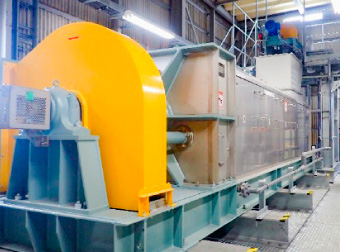
Recycling of Used Organic Solvents
Organic solvents used in chemical reaction processes are usually incinerated as industrial waste, but the Naoetsu Plant is working to reduce the amount of waste solvent that becomes industrial waste by refining and recycling solvents that have already been used. In FY2024 we continued to increase the variety and volume of recovered solvents through process improvements, achieving a further 13-ton reduction in waste solvents compared to the previous fiscal year. Going forward, we will continue to study process improvements to conserve resources and reduce environmental impact.
Metrics and Targets
FY2024
- Targets
- Achieve zero waste emissions.
Promote the reduction of waste generation in terms of production intensity. - Results
- The final waste landfill disposal rate was 0.86% in Japan
- Evaluation
- The target was achieved in Japan
FY2025
- Targets
- Achieve zero waste emissions.
Promote the reduction of waste generation in terms of production intensity.
*The scope of target for the waste reduction is Shin-Etsu Chemical Co., Ltd. and consolidated in Japan.
We outsource waste disposal to an external contractor (a company licensed under Japan’s Act on Waste Management and Public Cleaning). We check to confirm that they handle disposals properly by regularly inspecting their operations.
Trend of Amount of Waste Recycled*
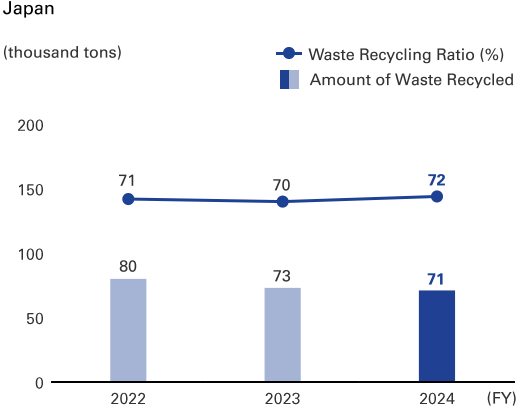
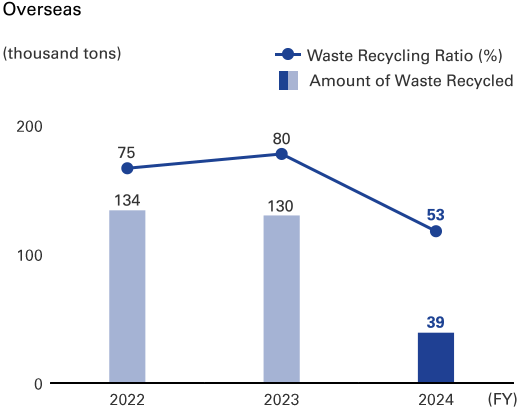
Trend of Amount of Waste Sent to Landfills*
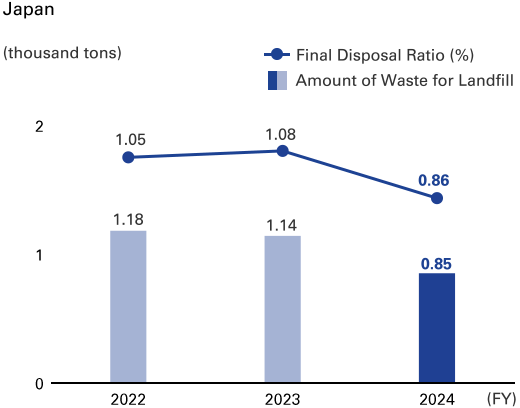

*Since the standards of waste differs between Japan and other countries, the graphs are shown separately.
Related Information
